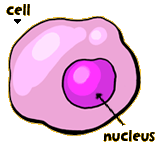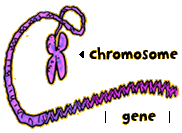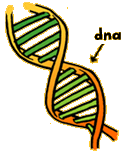UNDER THE MICROSCOPE
Inside every cell in your body, there is a set of instructions for the cell and a means for carrying out the instructions. The instructions in the cells affect everything from your eye color to how your body responds to infections. Genes are a part of that cell-level system.
Imagine it! The billions of cells in your body follow this system and make everything happen for you. You can think, move, and digest food. Your hair grows. Your body grows and changes.
Now, let's look under the microscope at critical parts of this "instruction and action" system for your cells.

Cells are the basic units that makes up living things. Cells are so tiny that they can't be seen without a microscope.
Each cell has a nucleus. Inside the nucleus are instructions telling the cell what its job is inside the body, and what it should be doing in order to accomplish its job. These instructions are in the form of DNA (deoxyribonucleic acid). DNA is like an instruction warehouse.
 Genes are segments of DNA. A gene contains the information needed to make a molecule called a protein. Proteins do the work inside the body, based on the instructions they get. For example, some proteins function as antibodies, protecting the body from diseases. Proteins help determine eye color. And, the hair on your head, and the enzymes that digest food in your stomach are made up of proteins.
Genes are segments of DNA. A gene contains the information needed to make a molecule called a protein. Proteins do the work inside the body, based on the instructions they get. For example, some proteins function as antibodies, protecting the body from diseases. Proteins help determine eye color. And, the hair on your head, and the enzymes that digest food in your stomach are made up of proteins.
 Chromosomes are made up of tightly packed DNA and proteins.
Chromosomes are made up of tightly packed DNA and proteins.
Inside its nucleus, each human cell has 23 pairs of chromosomes—for a total of 46. In each pair of chromosomes, one comes from dad and one from mom. This is why you have characteristics from each of your parents.
Alleles help to determine physical characteristics. Alleles are forms of the same gene with small differences in the sequence of DNA. Here's an example. Let's say the gene for eye color has alleles for brown, blue, black, and green. If mom and dad both have brown, baby will have brown. If mom has brown and dad has blue, the dominant allele will be baby's trait (brown eyes).

- Page last reviewed: May 9, 2015
- Page last updated: May 9, 2015
- Content source:



 ShareCompartir
ShareCompartir